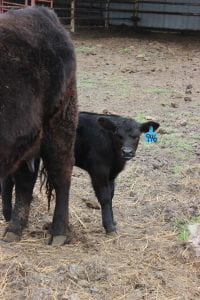By Sandy Johnson, Extension Beef Specialist, Colby
Benchmarking is a useful tool that allows businesses to compare their performance to others. However, limited data is available to cow/calf producers for this purpose. Management practices associated with calving can influence calf health and survival. A recent publication reported data from western Canada and describes calving management practices used in 2016 and the relationship of herd demographics with various measures of calf health.
 Survey responses were returned from 97 of 110 herds from Alberta, Saskatchewan and Manitoba. This region produces 77% of the beef animals in Canada. Study herds participated in the Western Canadian Cow-Calf Surveillance Network and were contacted through their veterinarian about participation in this survey. The majority of producers (74%) identified themselves as commercial producers and 21% identified as herds with both commercial and purebred dams. The median herd size was 226 with a range of 37 to 2,615 calving females. Data reported were limited to winter/spring calving. The proportion of herds that started calving cows each month was 17.9% for January, 20% for February, 33.7% for March and 28.4% for April or May. Heifers calved for an average of 58.9 days (range 10 to 129 d) and cows for 85.6 days (range 37 to 189 d).
Survey responses were returned from 97 of 110 herds from Alberta, Saskatchewan and Manitoba. This region produces 77% of the beef animals in Canada. Study herds participated in the Western Canadian Cow-Calf Surveillance Network and were contacted through their veterinarian about participation in this survey. The majority of producers (74%) identified themselves as commercial producers and 21% identified as herds with both commercial and purebred dams. The median herd size was 226 with a range of 37 to 2,615 calving females. Data reported were limited to winter/spring calving. The proportion of herds that started calving cows each month was 17.9% for January, 20% for February, 33.7% for March and 28.4% for April or May. Heifers calved for an average of 58.9 days (range 10 to 129 d) and cows for 85.6 days (range 37 to 189 d).
Calving assistance was provided for 4.9% of all births (13.5% heifers, 3.2% cows). These values are similar to the 4.8% of assisted births total and 11.6% for heifers and 4.3% for cows reported in Beef 2007-2008 by the USDA National Animal Health Monitoring System.
Incidence of a caesarian section was 0.7% for heifers and 0.15% for cows. Treatment for disease preweaning averaged 9.4% per herd. Three percent of calves were treated for neonatal calf diarrhea, 3.8% for bovine respiratory disease and 2.6% for other diseases. Preweaning mortality was 4.5%.
For most herds, heifers (66.6%) and cows (76%) were moved to specific calving areas less than 1 week to 3 weeks before calving and only moved into a barn if they needed assistance with calving: heifers (56.5%) and cows (55.8%).
Management decisions for checking for signs of calving and providing assistance were generally similar for cows and heifers. The survey asked how often dams were checked during daylight hours. For heifers, 25.3% reported at least hourly or every 1 to 2 h, 56.8% 3 to 6 times per day, 11.6% twice daily and 6.3% once daily or other. Cows were checked twice daily by 24.5% of producers with fewer herds checking at the more frequent intervals as compared to heifers. Heifers were checked during the nighttime hours at least hourly or every 1 to 2 h by 18.5%, 3 to 6 times per day by 32.6%, twice daily by 16.3% and once daily or other by 32.6%. Producers were asked `how long do you wait to assist when the water bag or feet are showing’ and `how long do you wait to assist when no progression is seen’. Responses were identical for both questions. For heifers, 34.5% waited less than 60 minutes, 39.3% waited 60 to 90 min, 17.9% waited 90 to 120 min and 8.3% waited over 120 minutes. For cows, 17% provided assistance after 120 minutes and 29.6% less than 60 minutes.
Methods and frequency to verify if a calf received colostrum were visualizing the calf nursing (93.7%), evaluating fullness of cow’s udder (83.2%), or assessing if the calf looked full (44.2%). Restraining the cow and helping the calf nurse was the most common method to ensure the calf received colostrum (43.2%), followed by placing the pair in a pen together (41%), tube feeding (24.2%) or bottle feeding (18.9%). The calf’s dam was the first choice for a colostrum source (68.7%), followed by a colostrum replacer (38.5%). Dairy colostrum was a source for 9% of producers.
Herds that started calving cows or heifers in January or February (early) had higher average herd-level incidence of calving assistance and pre-weaning treatment of disease than later calving herds (March, April and May). The incidence of stillbirths in cows was lower in later than early calving cows as was preweaning mortality. Herds with later calving heifers or cows were less likely to pen a dam and calf together to encourage colostrum intake or feed frozen colostrum. Herds that calved earlier were more likely to check on dams more frequently during daylight and nighttime hours than herds that calved later. No association was found between herd size (small < 300 dams, large ≥ 300 dams) and herd-level incidences or management steps.
Calving management practices vary with region, herd size and facilities. Weather conditions can be quite variable from one calving season to the next and in the long-term production systems must consider this variability. The western Canada data represent a harsher environment than many US cow-calf production systems yet can still provide insight into management choices. Conclusions regarding cause and effect should not be drawn from these data.
Only some aspects of the survey data have been shared here, however, readers interested in the complete report can access it online at https://doi.org/10.1093/tas/txz107 .